PanPan CrewWatcher, smart MOB beacon for smartphones, plus Sea Tags & Fell MOB+
Does it make sense to use smartphones and tablets for a man overboard alarm and recovery system? I can testify that the first reaction of Sail magazine’s Pittman Innovation Award judges was skepticism. Nonetheless we found PanPan’s CrewWatcher so well thought out and potentially so useful that we gave it an award in the safety category, and then an independent second set of judges picked it for the Overall Winner. And truth be told, the finished CrewWatcher personal beacons and apps don’t actually exist yet!
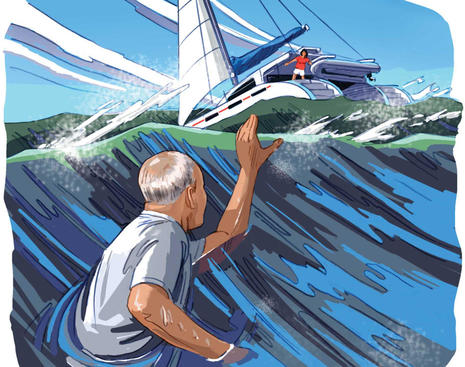 “Everyone’s OK” — or to be more specific, “everyone is still on the boat” — is one hell of a nice thing to know when you’re underway, especially in the dark or when it’s rough, or both. In many situations if you don’t learn that a person has gone overboard quite quickly, he or she is going to die, possibly not quickly. I worry about this, even though I’ve yet to experience either side of a person overboard situation (like the extra scary one above). So I not only appreciate the evolution of personal MOB beacons, I particularly like the type that can regularly reassure me that they’re working.
“Everyone’s OK” — or to be more specific, “everyone is still on the boat” — is one hell of a nice thing to know when you’re underway, especially in the dark or when it’s rough, or both. In many situations if you don’t learn that a person has gone overboard quite quickly, he or she is going to die, possibly not quickly. I worry about this, even though I’ve yet to experience either side of a person overboard situation (like the extra scary one above). So I not only appreciate the evolution of personal MOB beacons, I particularly like the type that can regularly reassure me that they’re working.
The PanPan CrewWatcher is just such an active MOB system, also termed “alarm on failure” when I tested Raymarine’s LifeTag a decade ago (more here). If set to Watch mode, the orange CrewWatcher beacons communicate every second over Bluetooth 4 with whichever Apple iOS or Android device you’re using the CrewWatcher app on. In fact, the Bluetooth signal strength icons animate reassuringly, as I tried to indicate with the inset above, and the beacon icons even wiggle when the actual beacons pass within a few feet of the phone or tablet. While you certainly don’t have to be looking at the app to know when a beacon’s connection fails, or if one goes in the water — escalating siren sounds, spoken “Man Overboard!” audibles, and strobing camera flashes take care of that quite well — it is comforting to have a lively screen indicating that everyone is OK.
If you read the full 2017 Pittman Innovation Awards report, you’ll see that the Overall Winner judges were especially impressed with the CrewWatcher’s ease of use, to which I can attest. The small orange beacons don’t have a switch or even battery access. You just install the app, tap the “Add a PanPan” button, and almost immediately you’ll be able to custom name a beacon with about as much detail as you’d like. In fact, judging from the images on PanPan’s site — my beta apps don’t have the feature yet — you’ll be able to add a photo of the person who will actually wear the 1.7-ounce beacon around their neck or carry it in their pocket. As shown, it’s also easy to rename a beacon, or disable one when you just want to keep a watch on others.
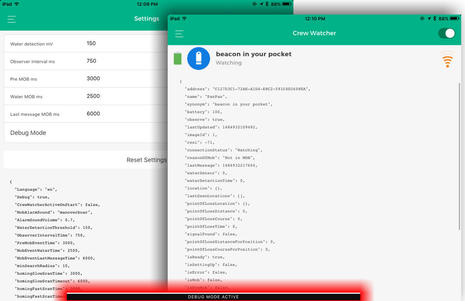 The prime enabling technology behind CrewWatcher is Bluetooth 4, also known as Bluetooth Smart or Bluetooth Low Energy. It’s why the beacon can be switchless even without a replaceable battery and still claim a three year lifetime of “normal use.” And while PanPan has not yet devised a beacon replacement program, I’ve seen a detailed battery life spreadsheet that suggests a much longer real lifetime for most boaters (and that will also be available on PanPan’s site soon).
The prime enabling technology behind CrewWatcher is Bluetooth 4, also known as Bluetooth Smart or Bluetooth Low Energy. It’s why the beacon can be switchless even without a replaceable battery and still claim a three year lifetime of “normal use.” And while PanPan has not yet devised a beacon replacement program, I’ve seen a detailed battery life spreadsheet that suggests a much longer real lifetime for most boaters (and that will also be available on PanPan’s site soon).
But when I began discussing the CrewWatcher with PanPan founder Jason Schot last November, I was impressed with how much thought his team was giving to false alarms. Bluetooth may claim ranges “up to” 100 or even 200 meters, but that’s line-of-sight in an ideal environment quite unlike the tangle of blocking objects and electromagnetic interference that is a typical boat. And too many false alarms can be the ruin of otherwise valuable safety devices.
There’s also a fundamental contradiction to an active wireless MOB system like CrewWatcher. You want maximum range for minimum false alarms, but you also want a real alarm process to start as soon as possible, especially in cold waters and especially with a system like this that can only capture the “point of loss” position (because the beacon does not have its own GPS, and will be out of touch anyway). Besides the many timing subtleties suggested in the beta Settings and debug screens shown above (which real owners will never see), the PanPan team has come up with three significant ways to deal with these issues.
First of all, the CrewWatcher beacon has a water detection sensor, and even the prototypes I’ve been testing are good at distinguishing the real thing from dampness and spray. Water detection triggers the MOB alarm routine when the Bluetooth connection is still active, and imagine how much you might appreciate that feature if you were being dragged off the stern by your tether. A think-outside-the-box friend even theorizes that he could use a CrewWatcher beacon as a high bilge water alarm on his own boat or when he’s crewing (see Roger Taylor’s wonderful Elements of Seamanship for advice on how to politely check the bilges of any boat you leave a dock aboard).
Moreover, by the time the CrewWatcher beacons ship, hopefully in March, the system will purportedly offer “meshing” — meaning that all watched beacons and app-running phones/tablets will form a network that allows the Bluetooth signal to find alternate paths throughout. Also in development is a choice of Bluetooth power levels, so a crew will be able to adjust the system to get maximum response with minimum false alarms for a boat’s particular size and composition (steel and aluminum boats will need more power and/or more populous beacon/app networks). And if you can use low power modes, according to the battery spreadsheet even heavy use shouldn’t flatten the battery thoughout its own nine-year lifetime.
Incidentally, other somewhat obvious uses for CrewWatcher besides regular person overboard situations include minding a tender you’re towing or an occasionally impetuous pet. (For instance, my longtime sailing companion, the springer spaniel Dixie Belle, once woke up from an after deck nap on Alice, took one whiff of the seal island close to windward, leapt overboard and swam about 25 yards that way before realizing that she was being quite foolish.)
Meanwhile, I actually took one PanPan beacon along with my iPad and granddaughter to a large demonstration on Saturday, though it turned she’s so smart she didn’t want to forge deep into the crowd. So, beyond-the-box readers, how else could the completely portable CrewWatcher be used?
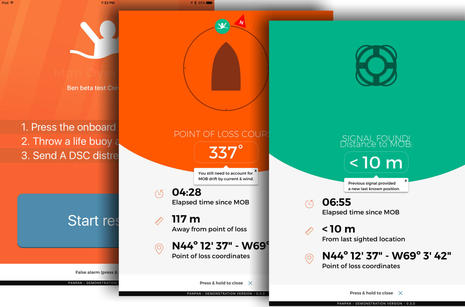 CrewWatcher’s already mentioned audible and flash MOB alarms are impressive (and work at full volume regardless of the device’s volume setting), and so are the screens that help guide a recovery. While I’ve yet to try it underway — I hope to soon, and it’s great that all owners can do extensive testing easily and often — walking simulations along my boatyard’s docks were promising.
CrewWatcher’s already mentioned audible and flash MOB alarms are impressive (and work at full volume regardless of the device’s volume setting), and so are the screens that help guide a recovery. While I’ve yet to try it underway — I hope to soon, and it’s great that all owners can do extensive testing easily and often — walking simulations along my boatyard’s docks were promising.
The point of loss in the screens above was about 30 meters from the boat, which I think realistic if the water sensor somehow stayed dry, and the 117+ meters I walked beyond that is about what it sometimes takes to get some boats turned around. The CrewWatch app guided me accurately back to the point of loss, near which I got the Signal Found notification and could have focused the final search and approach. Better yet, I know that the PanPan team is working on spoken guidance for the whole recovery process, which will mean not having to look at the screen at all.
But obviously what I’ve been testing so far is not exactly the promised CrewWatcher system that is now available to pre-order and that is deservedly getting publicity, and that’s a little vexing. Normally when I get to beta test a product, it’s mainly useful so I can write better about it when it’s announced. I don’t usually discuss beta bugs because they’ve been fixed. In this case, however, I must tell you that CrewWatcher does not work properly with my Samsung Note 4 phone running Android 6.0.1. Actually, it can pair with the beacons and appear to watch them, but neither signal loss nor water detection triggers the alarm, which is worse than not working at all (and just one reason that user testing is important).
The PanPan team is surprised by my test trouble, can’t duplicate it on a phone also running Android 6.0.1, and are sending replacement prototype beacons that may work fine. But then again, Android is notoriously “looser” than Apple’s iOS and it’s still not uncommon to see Bluetooth devices accompanied by specific lists of just which Android phones and tablets are proven to be compatible. Plus, there’s a caveat about using any smart thing in a safety system that’s well beyond beta issues and probably can’t be overcome by even the smartest developers…
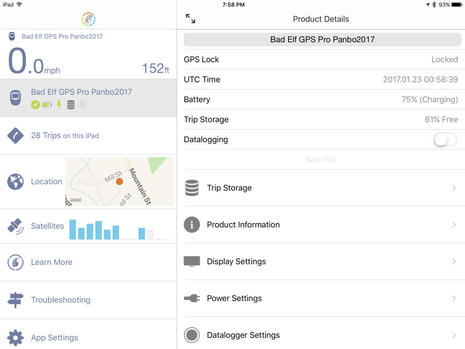 Let’s call it the Bad Elf phenomenon (sorry, Elf). I enthusiastically reviewed the Bad Elf Pro Bluetooth iPad GPS in 2012, and I know that many users also came to think of it as an excellent and reliable alternative to the extra cost of an iPad with an internal GPS. Its receiver is much better, it’s much more informative, and it can also log detailed track information, even stand alone. Plus, I’m happy to report that the sample unit was still working fine when I fired it up for CrewWatcher testing, and, in fact, the product has gotten better. The Bad Elf app offers a lot more features, and it also easily updated the hardware’s firmware so the Pro can now simultaneously send its data to some Android devices (though not, ahem, my Note 4).
Let’s call it the Bad Elf phenomenon (sorry, Elf). I enthusiastically reviewed the Bad Elf Pro Bluetooth iPad GPS in 2012, and I know that many users also came to think of it as an excellent and reliable alternative to the extra cost of an iPad with an internal GPS. Its receiver is much better, it’s much more informative, and it can also log detailed track information, even stand alone. Plus, I’m happy to report that the sample unit was still working fine when I fired it up for CrewWatcher testing, and, in fact, the product has gotten better. The Bad Elf app offers a lot more features, and it also easily updated the hardware’s firmware so the Pro can now simultaneously send its data to some Android devices (though not, ahem, my Note 4).
Regular improvement is what we can cheerfully expect from a well-designed and supported Bluetooth smart device, and I’m quite confident that PanPan is like Bad Elf in that regard. But there was a period when this smart BT product suddenly could not communicate with smart mobiles at all. If you were a skipper who depended on the Elf for your navigation app, and you let your iPad update to iOS 8.3 last April, you lost GPS until 8.4 came out in late June, despite what I imagine were some pretty heated communications to Apple from the Bad Elf crew and other manufacturers of Bluetooth GPS products. Companies like Apple, Google and Samsung can barely see down to boaters or boating developers over their very large bellies.
This is not the only problem Bad Elf has suffered with new iOS versions and they’ve documented them well as part of their prophylactic “Cleared to Update Program.” So, while I intend to continue testing the CrewWatcher beacon and app system up to and beyond its ship date with high expectations, we should all realize that a wrench could be dropped into the works by any “smart” device update and it might not get fixed quickly.
Sea Tags & Fell MOB+
![]() Oddly enough, there is another Bluetooth 4 MOB system that’s available for pre-order, though I can only report what’s on the Sea-Tags website. I do not see any mention of water detection, let alone meshing or BT power level control, but some may like the watchband form factor, and at first I found the mapping in the app attractive. But when asked, Jason Schot pointed out that mapping is usually irrelevant at the scale of MOB situations, and I think he’s right.
Oddly enough, there is another Bluetooth 4 MOB system that’s available for pre-order, though I can only report what’s on the Sea-Tags website. I do not see any mention of water detection, let alone meshing or BT power level control, but some may like the watchband form factor, and at first I found the mapping in the app attractive. But when asked, Jason Schot pointed out that mapping is usually irrelevant at the scale of MOB situations, and I think he’s right.
The Sea-Tags app can be configured to text an emergency contact but I have a hard time picturing how that would be helpful. If you are a single-hander, for instance, going overboard is a different and even more serious problem than what I’ve been discussing, and the more appropriate device to have with you is a Personal Locator Beacon, an AIS MOB beacon, a handheld DSC VHF radio, or ALL of the above (and a gumby suit).
I have not seen a Fell Marine MOB+ system in the flesh either, but I detect the sort of thoroughness and design smarts I’m finding with CrewWatcher. Note, for instance, how a single pocket beacon can also be used with an optional wristband, floating lanyard, or belt clip. Also, note that the MOB+ is quite different from CrewWatcher, being a wireless engine kill switch meant for smaller boats and tenders.
I guess you’d have to say it’s not “smart” either — as apps, phones, and Bluetooth aren’t involved — but don’t they also say that there are many forms of intelligence? Check out Fell’s MOB+ install video, for instance; I not only see numerous impressive hardware details, but also a clear and informative animation style that other electronics manufacturers might be wise to emulate.
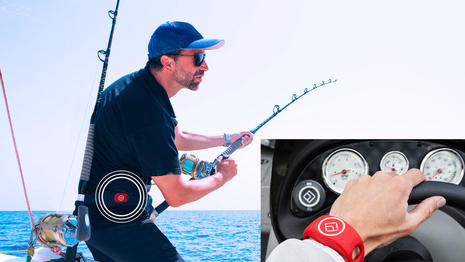 That’s the Fell MOB+ in action above, and last, but not at all least, is a look at what I hope to test next, and sometimes next to the much less expensive CrewWatcher. I’ve tried other AIS MOB devices before, but this new ACR AISLink personal MOB beacon looks particularly well-made and designed, and it also has the added RescueMe style DSC VHF alarming I suspect to be very valuable. It already looks as though programming it with my boat’s MMSI number is easier than I feared — the process is wireless with even an app — and I predict that the testing will shred the one CrewWatcher claim, “30x AIS” speed, I’m already quite dubious about. Plus, of course, MOB alarm speed has a different value when your beacon has a GPS and can transmit your position to your own vessel and others within a few miles.
That’s the Fell MOB+ in action above, and last, but not at all least, is a look at what I hope to test next, and sometimes next to the much less expensive CrewWatcher. I’ve tried other AIS MOB devices before, but this new ACR AISLink personal MOB beacon looks particularly well-made and designed, and it also has the added RescueMe style DSC VHF alarming I suspect to be very valuable. It already looks as though programming it with my boat’s MMSI number is easier than I feared — the process is wireless with even an app — and I predict that the testing will shred the one CrewWatcher claim, “30x AIS” speed, I’m already quite dubious about. Plus, of course, MOB alarm speed has a different value when your beacon has a GPS and can transmit your position to your own vessel and others within a few miles.
Yes, the evolving world of MOB beacons is another confusing one, but there are many promising and valid options.



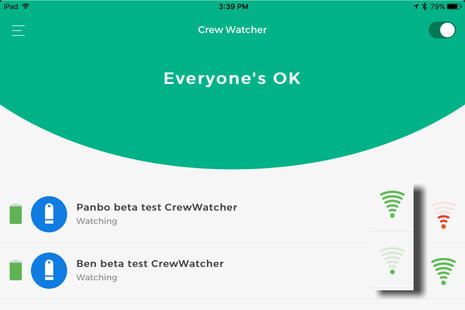

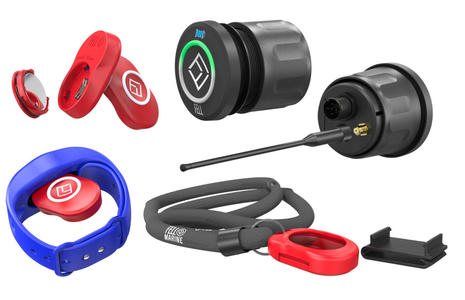
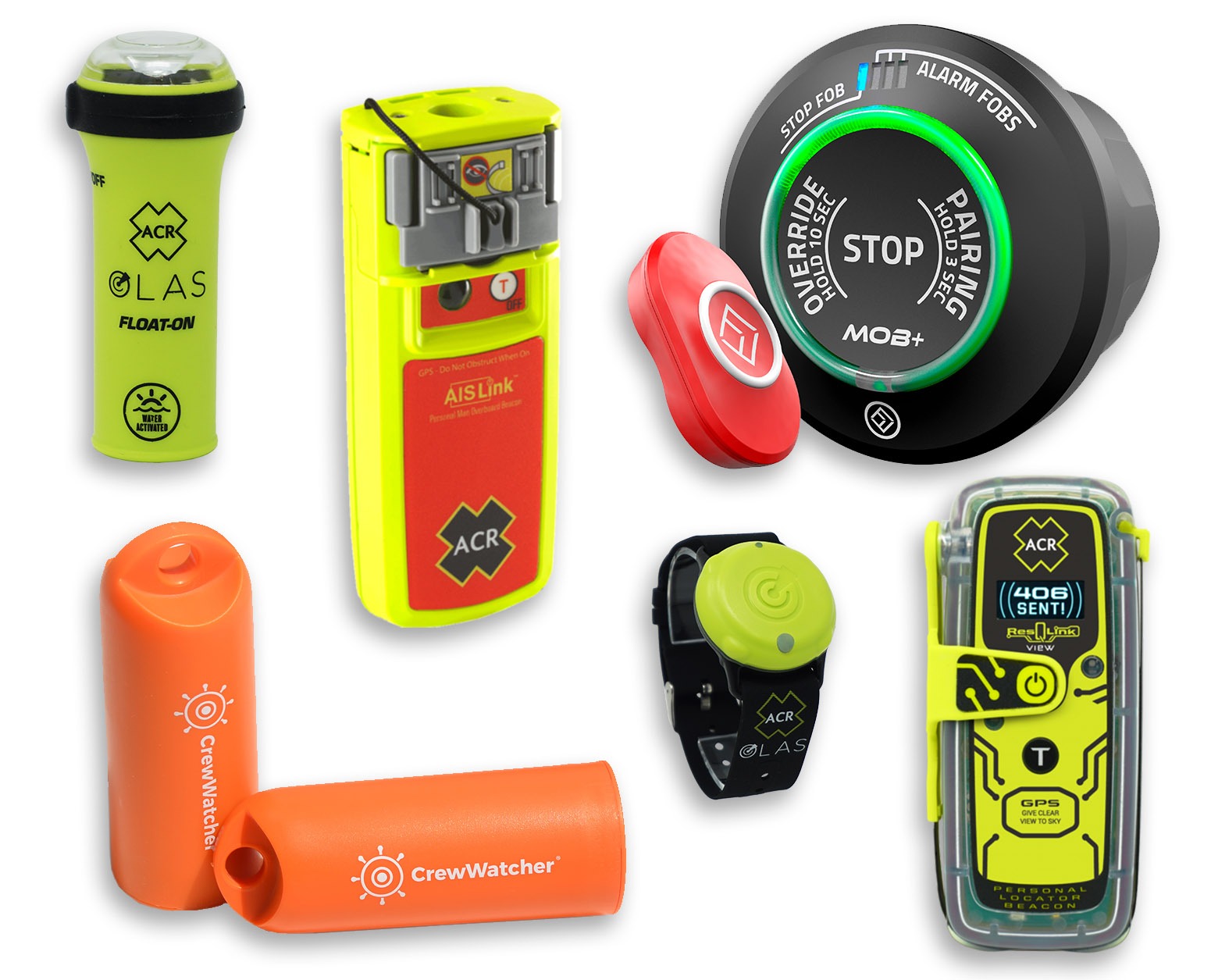
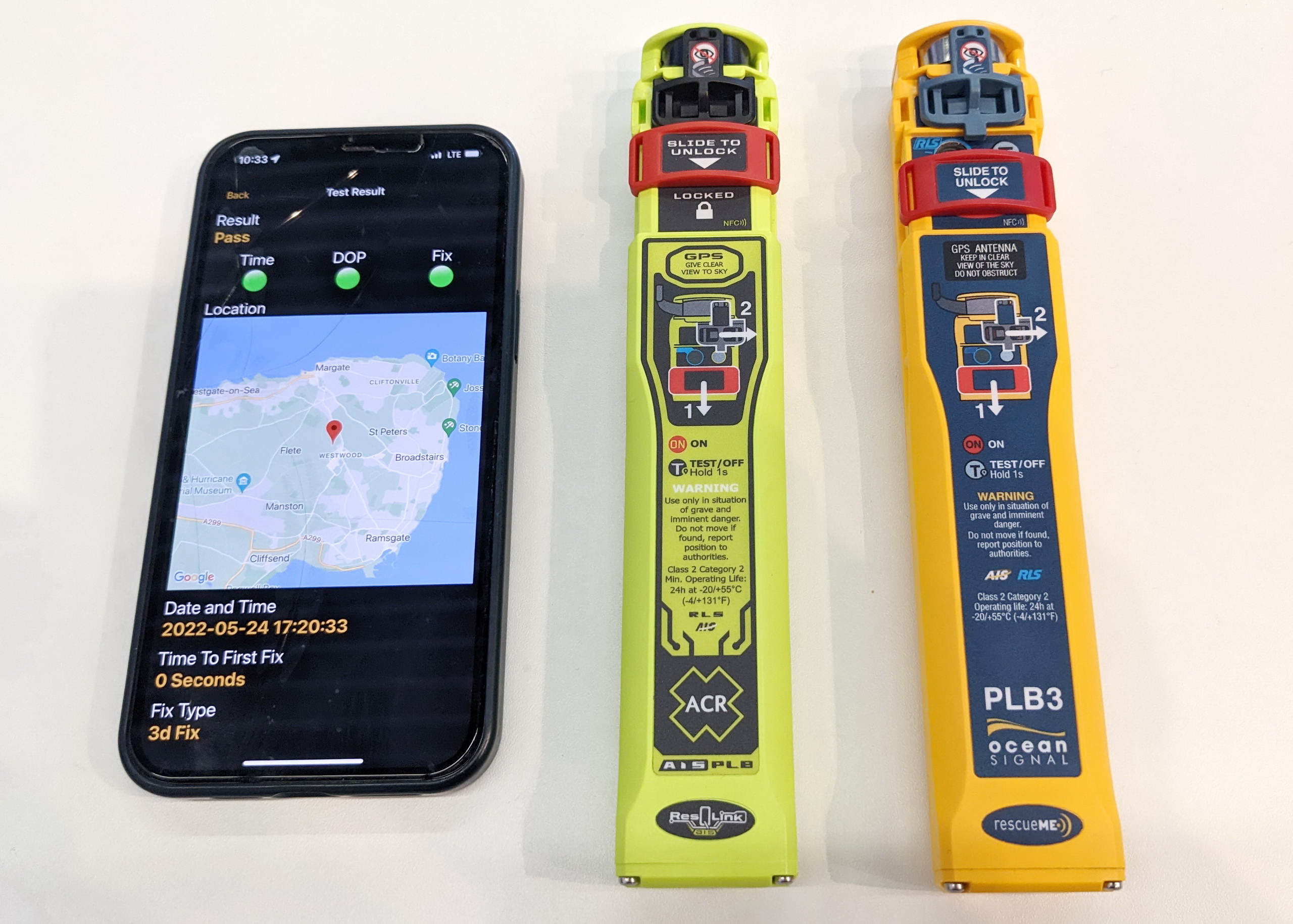









Hi all, Jason here.
I’m happy to answer any questions you might have about Crew Watcher by PanPan.
I’d love to hear your thoughts.
When the Raymarine product came out I opinied what changes would make it more useful. It seems like it is nearly all covered and more but two things standout.
1. Triggering the chart plotter through nmea 2000 or 0183 with an MOB alarm so it’s alarms and MOB charting features can kick in with gps based functionality. Have you given this thought? Maybe collaborate with Kees and Signal K?
2. Handling the frequent use case of returning to dock and your crew walking away with the beacons, I had proposed putting a tiny waterproof noisemaker on the beacons so they can alert the wearer to return the beacon to the boat (because they are out of range without getting a shutdown signal) Any thoughts about that?
Adding Signal K message to cover these types of alarms certainly makes sense. Signal K is able to accommodate more data attributes than possible in AIS messages, such as names and other stuff set in the app. Right now I’m sure Jason is focusing on getting his product out the door first 🙂
Ah, I found the last post I made on the Raymarine LifeTag where I wrote “I have enough things to do when I return to the dock, then to chase crew down for their life tag�s. Is there a function on the tag�s to alarm if you move out of 30 feet range? e.g. to warn crew to return the tag to the boat before they drive home after a sail?”
https://panbo.com/archives/2007/02/yet_more_lifetag_battery_issue_resolved.html
Some other thoughts I see I had back then:
* add a function on the base station to get all the tags to chirp so you can find where your crew hid them from the last use. — instead this would be add a function on the smart phone to get all or just selected beacons to chirp so you can find them.
* Add a function on the smart phone app to list the beacons in range, so you can find out if a beacon was left behind at a dockside restaurant, before you depart.
I also had a thought about a button on the beacon. That was more around a power saver mode, but it could still be useful. For example push the button to silence an alert you have to return the beacon to the boat, could also be useful in combination with the smartphone app to do an inventory of beacons or at the end of a boat trip switch the smartphone app into a beacon return mode and push the button to acknowledge you got it back from the user.
He Dan,
Thanks for sharing your thoughts!
We are very excited about the Signal K possibilities and already have some ideas for it. Kees is right tough, we are currently focused on getting V1 out the door.
Since a lot of the product is software it’s never really finished.
We intend to keep adding great features by letting our customers vote for what they’d want to see next.
I have to disappoint on the speaker in the beacon for this version since we are already starting production. That said, it’s a great idea with a lot of possibilities.
If your crew leaves the boat with your beacons you will know soon enough as the alarm will go off on your phone.
Listing the beacons in range is already possible by simply turning the crew watcher on. All in range will connect the others will not. You can then use the signal icon to use a “hot/cold” principle to find any lost beacons.
Thanks for making yourself available here, Jason, and please don’t mind Dan. His specialty is overcomplicating everything in sight. Just kidding, D, but perhap this is a simpler and doable solution:
When I noticed that the CrewWatcher app screens on the PanPan site use photos as well as names to ID beacon users, I wondered if they were being plucked from the phone’s contact list. Is that possible, Jason?
If so, would it also be possible to add a “Call Ben (or whoever)” button to the individual beacon pop up menu? Then racers like Dan could leave the app running at the dock and if one of their crew ran away with a forgotten beacon after a tense race, then — tap, tap — he could call them and say “Pretty please bring the %$)!??? orange thing back.”
The feature might be handy in other ways too, like private intercoming around large yachts with extensive CW meshes 😉
That is a superb idea Ben. We will add it to the development list.
I do think it will have to be combined with just regular photo picking.
I for one do not have pictures for all my contacts.
Interesting device!
A couple of thoughts:
1. Put one inside the outboard motor cover when in areas prone to thievery.
2. I wouldn’t think the “receiver” end would need network connectivity, so you could acquire a cheap device that could be integrated to the system full-time, and not require the captain/safety officer to have their phone in their pocket – especially useful once you’re offshore and the fone doesn’t have service anymore.
3. Needs a credit-card size transmitter to put in my wallet. 🙂 [Or maybe my hat, Ben?]
He Hartley,
One thing on our list is actually a property mode. Where you can attach a beacon to for example a dinghy or of course, an outboard motor.
You actually don’t need a cellular network. The system creates an in depended network of Bluetooth so it will do just fine offshore.
Ben is on to something about using the users on smartphones to notify them they need to return a beacon. It would be a big step improved if it was automatic so that when a beacon goes out of range the contact associated with the beacon is automatically texted “URGENT: Crew Watcher – Either you fell off the boat, or you have departed the boat without returning my orange safety beacon. Please return the beacon right back to the boat. Disregard this message if you fell off the boat, in which case stay where you are and we will come back for you”.
This approach still has that extra effort of associating the cell phone to the beacon, which would not be needed if their was a noise maker in the beacon.
Maybe that extra effort could be reduced if you did the following:
1. Make the feature person centric rather than beacon centric.
2. In the app keep a list of people who have already been registered to a beacon in the past; allow additional crew to be added to the list; then make the association from this list to a beacon when handing out the beacons.
3. Allow the app to work in a self-serve mode which disables to screen lock, so my crew can go to my smartphone, choose themselves or enter a cell #, pick a beacon and associate the two.
You mentioned a mesh network? To make this more complicated, make it so that I can leave simple instructions for my crew to do the following
1. Download CrewWatcher app from your app store
2. Search for Breeze Pleeze 51300
3. Choose a beacon from the box
4. Find the beacon label on the app
5. If you don’t mind your battery running down a little bit, choose Mesh Network to help with our safety monitoring today.
6. If you take any pictures during our sail today, share them with the CrewWatcher application and we will all get a copy. Thanks!
Yea, this may seam like a lot of extra software work, but this use case (crew walks away with beacon) will be 100’s of time more frequent than crew falling in water, and should be optimized for the captain.
Since this is all about safety, maybe another thought is to take the idea of getting everyone’s contact information and pictures, and go the step of creating an automatic float plan that is kept on your server with a link that is emailed when the boat departs to key contacts.
edit: users own smartphone
Useful for monitoring a dementia/altzheimer stricken family member? No walking away from home.
@Dan, I wouldn’t use all that complication. I’d stick them in the boat’s lifejackets. I don’t allow crew to use their own as I have better ones than their own (mine are all Spinlock or Secumar 275N).
@Dan, We have added the contact sync to our development backlog since it provides a lot of useful opportunities.
That said, it is at the end of the backlog now so we have to evaluate related features when we get there. I do see some difficulties with your proposed idea;
You probably only want to alert if the crew watcher is turned on and the beacon goes out of range. In this case you would already receive an alarm (a MOB alarm)
the person walking off with the beacon would then still be in “shouting distance”
What happens if it would also work when turned off? You leave the boat and the beacons but take your smartphone home. Then everyone would receive a text asking to return their beacon.
Kees’s solution would be very effective as well.
You’d have to have lifejackets to spare tough.
Jason.
He Viddix,
One of our earlier projects was actually in a similar space; kids.
Depending on the size of the home you could indeed use PanPan as a “wandering” alert.
Ben, I like your idea of the call option popping up when a beacon leaves the boat. Was thinking something similar, but with one other enhancement – geo-fence the feature, so that an automatic call to the beacon wearer is made when he/she leaves the boat, ONLY when the app host phone (and therefore vessel) is in the Marina.
I see the idea of alerting the crew they are walking away with the sensor is best done with a noise maker in the sensor. Until then ideas such as this from Mr. Complicated, going back to 2009 mind you, will sit here like treasures hidden in the comments of Panbo.
I sense this product will do well on the market as envisioned, it just would be better if.
I can see an absent minded person sticking a CrewWatcher beacon in their backpack, attache case, or purse, just in case. Of course the app will also alarm if the item itself “walks” away.
But everyone should realize that in either of those cases, you will not know what direction the item is in, or even was in when the signal was lost (unless you remember where you left it). You’ll only know where the app-running device was; that’s the “point of loss.” In other words, MOB situations where the boat keeps on moving — sometimes for quite a while, and where one location looks exactly like another — are pretty ideal for this type of alarm system. “Wandering” is not, as best I can figure.
Forgive the distraction, but that picture bothers me. Most people swim IN the water, and he is not walking on it. There is a similar FLIR screenshot which often appears in ads and articles, where the swimmer has both hands waving above her head. In the FLIR shot I think she was wearing a survival suit, so maybe that’s possible. So I had to read the linked article. In the movies, they have a catch phrase “based on true events” which gives Hollywood a generous artistic license. Either that is happening here, with some exaggeration, or the story is just plain made up. True, MOB is scary; this story, not so much. If you want realistic stories about MOB mid-Atlantic in a big storm, I recommend “Sailing a Serious Ocean” by John Kretschmer.
https://www.amazon.com/Sailing-Serious-Ocean-Sailboats-Stories/dp/007170440X/
Norse, I presume you mean the illustration from the Sail article written by the first mate on the stern of the catamaran?
http://www.sailmagazine.com/cruising/opinion/man-overboard-in-the-middle-of-the-atlantic-ocean/
I agree that it’s technically unrealistic but maybe the illustrator Steve Sanford better expressed the desperation of the situation by showing us more of the skipper than, say, the back of his head and an arm?
http://www.stevesanfordartist.com/
PS It’s quite possible that the author of that story never saw the illustration until it was published. Regardless, it seems rough to accuse her of making it up. It is remarkable that she, or anyone, got back to the MOB but I can assure you that Sail is careful about such things.
Incidentally, I have experienced a PFD that comfortably held me remarkably high, even in fresh water with lots of clothing on:
https://panbo.com/archives/2005/08/mustang_lift_vest_a_real_winner.html
I have no idea why the amazing Mustang L.I.F.T was discontinued:
http://www.landfallnavigation.com/liftvestpfd.html
When I go MOB, I want one of those LIFT inflatables and one of those smoke flares!
According to the link, that PFD had 40 lbs floatation. The usual Mustang vests now have 35, but the Mustang Survival EP38 has 38 lbs. And it has additional features: spray hood, storage for AIS, PLB, strobes, and other electronics, and a sailing harness and crotch straps.
http://www.landfallnavigation.com/mustang-ep38-md6284.html
Although the LIFT PDF was discontinued, maybe some of its innovation was carried on in other models.
Regarding the SAIL story, everyone makes mistakes sometimes. I can expand on that later, or not. Anybody reading it can judge for themselves.
“Everyone Makes Mistakes Sometimes” would look good embroidered, framed, and velcroed to a bulkhead alongside the “Boat Sweet Boat” homily. And if you make enough mistakes, or know someone who qualifies, you should head right over to Despair,Inc. for this bit of wisdom:
https://despair.com/products/mistakes
While these smartphone based safety devices are admirable they are not configured or configurable as safety critical devices. The manufacturing quality of these consumer grade / low volume devices often leaves a lot to be desired especially when aren’t in daily use or tested. Hacking a phone app is magnitudes more trivial than building mission and safety critical hardware that is reliable.
We’re close to having a good MOB sensor / effector in terms of features and functionality but none of these devices are triggering me to buy just yet. They will all need to be idiotproof, tamperproof, have AIS, GPS, two way comms, diagnostics, certification, vital sign monitoring, auto strobing above the wave line and simply and reliably able to be tied into the main vessel NMEA2K system.
Bluetooth is not a great mission critical protocol although the low energy variants are getting better. Signal K compatibility is also on my mandatory list of must haves. Open standards are the only viable option for interoperability these days now that the DoD Mil Stds and Specs are mostly retired.
That said there is a place for training and mandated / checked safety initiatives for boat owners. I know many abhor more government intervention but it’s much easier for a clueless or ill prepared boat owner to put innocent people in harms way. Just this week I saw a baby unattended in a pram on the dock. I shuddered at the potential for something bad to happen. No safety device is going to help mitigate the risk in this situation.
Love your posts. Detailed and the comments are also useful to keep up to date.
Leftbrain, gosh, I think general purpose programmable devices that are cost effective to update and deploy new software (aka smartphones) is an excellent platform for a MOB solution.
Dedicated hardware can just as easily have bugs and flaws in it, but then they become difficult to update and impossible to be sure consumers have updated. Using smartphones also reduces the costs to make MOB devices cost effective. Especially if you only have 1 crew to protect (somebody sleeping vs someone on watch), this seems very cost effective.
The Sea Tags MOB system is now available in North America from Fugawi:
https://www.fugawi.com/store/product/ST-ST1?taxon_id=91
The Fell MOB+ too.
Cool!
“Weems & Plath has been named the exclusive manufacturer and distributor of CrewWatcher, a system of beacon and app that is an affordable crew overboard alarm & locator. We are very excited about this new product. We will feature it for the first time at the Annapolis Sailboat Show.”
My take: CrewWatcher couldn’t get better distribution and support, and PanPan will get the time to develope new products and fine tune CrewWatcher if needed (even the beacons can be updated over the Internet now).
The CrewWatcher MOB system has some serious competition for the DAME Award. Meet the OLAS Float-On:
https://www.youtube.com/watch?v=e3HL7Q6jhCQ
CrewWatcher wins the DAME Award for safety products, big congratulations to PanPan and Weems & Plath
https://www.metstrade.com/innovation/dame-winners/
The Weems & Plath CrewWatcher is not yet in full production but West Marine seems to have a early batch:
https://www.westmarine.com/buy/weems-plath–crewwatcher-mob-system-two-beacons–18860437
I don’t think that the Exposure OLAS Float-On combination flashlight, strobe, and Bluetooth MOB tag is shipping yet but their wrist tags are… https://goo.gl/sauJiY …and so are Sea-Tags, as I mentioned above.
In other words, three different Bluetooth MOB systems should get a lot more real world testing in the coming months (and I hope that some of those users will report in).
Incidentally, and especially for owners of open power boats, I saw the Fell MOB+ demonstrated at IBEX and was quite impressed. It too is shipping:
https://www.fugawi.com/store/category/67